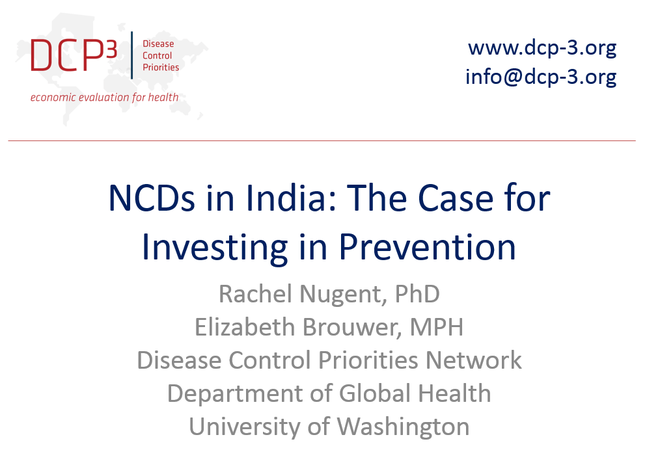India Perspective: Non-Communicable Diseases
India already has the world’s second largest population and is expected to overtake China before 2030. At the same time, the population is becoming older and more sedentary. The country is undergoing a demographic transition and is also experiencing an epidemiological transition, with non-communicable diseases (NCDs) – a result of lifestyle rather than infection – becoming an increasingly important factor in life expectancy.
NCDs now account for the majority of death and disability in the country and affect in particular adults in the productive years between 30 and 69. Most of these conditions are caused by underlying (and often inter-related) risk factors such as smoking, high blood pressure, obesity and lack of exercise. 15% of Indian females and 12% of males are classified as overweight or obese and about 30% have high blood pressure (hypertension). Rates of hypertension are generally higher in urban areas, an important factor as more and more people are moving to cities from the countryside.
The government has in recent years set up two programmes to address NCDs, the National Programme for Prevention and Control of Cancer, Diabetes, Cardiovascular Diseases and Stroke (NPCDCS) and the National Programme for Health Care of the Elderly (NP{HCE), but there are further cost-effective interventions which can be made to reduce tobacco use and hypertension.
About 10% of all the world’s smokers live in India and about a million of these die every year from tobacco-related disease, including cancer, heart disease, diabetes and respiratory conditions. This costs the economy about one million crores of rupees every year ($22.4 billion). Almost 60% of men and 11% of women under 50 use tobacco products, although women are more likely to chew tobacco than smoke. Smoking rates are higher in rural areas and among poorer groups in society.
In 2003, a number of restrictions were imposed on tobacco advertising and sale and smoking in public places was banned. More recently, excise duty was raised, but the various types of product are not taxed uniformly. In particular, the bidi (made with uncut tobacco rolled in leaves) which is the most widely-used tobacco product and generally bought by the poor, is lightly taxed and over half of those consumed are believed to have had no tax paid on them at all.
Consumption could be decreased by raising taxes, with the bidi market being particularly price-sensitive. 1.17 million tobacco-related deaths are projected for 2030, but between 65,000 and 90,000 of those lives could be saved each year by increasing taxes by 35% and 45% respectively. Each rupee spent on implementing the tax increase would pay back between 28 and 38 rupees in benefits. To achieve this, it is important that the tax system is simplified, made more transparent and properly enforced. The additional revenue would be very useful for funding programmes to reduce smoking and improve health in other ways.
Hypertension is a risk factor for heart disease, stroke and diabetes, and about 11% of all deaths in India are attributed to it. Only about a third of people suffering from high blood pressure are aware of it and of those only about half are managing their condition successfully. People considered to be at medium to high risk of heart disease or stroke are treated with a combination of readily available and inexpensive medicines including aspirin, beta-blockers and statins.
Raising the number of diagnosed patients who treat their condition from 33% to 75% would reduce deaths by 110,000 a year in 2030, assuming treatment was successful in half of cases. The cost would be only about $10 per patient per year, and the average return would be R4 for each rupee invested. An alternative would be to raise the success rate of treatment from the current 50% to 90%, by making free medication as widely available as possible, which could save a further 90,000 lives. Spending a rupee on this would pay back about R7 in benefits.


